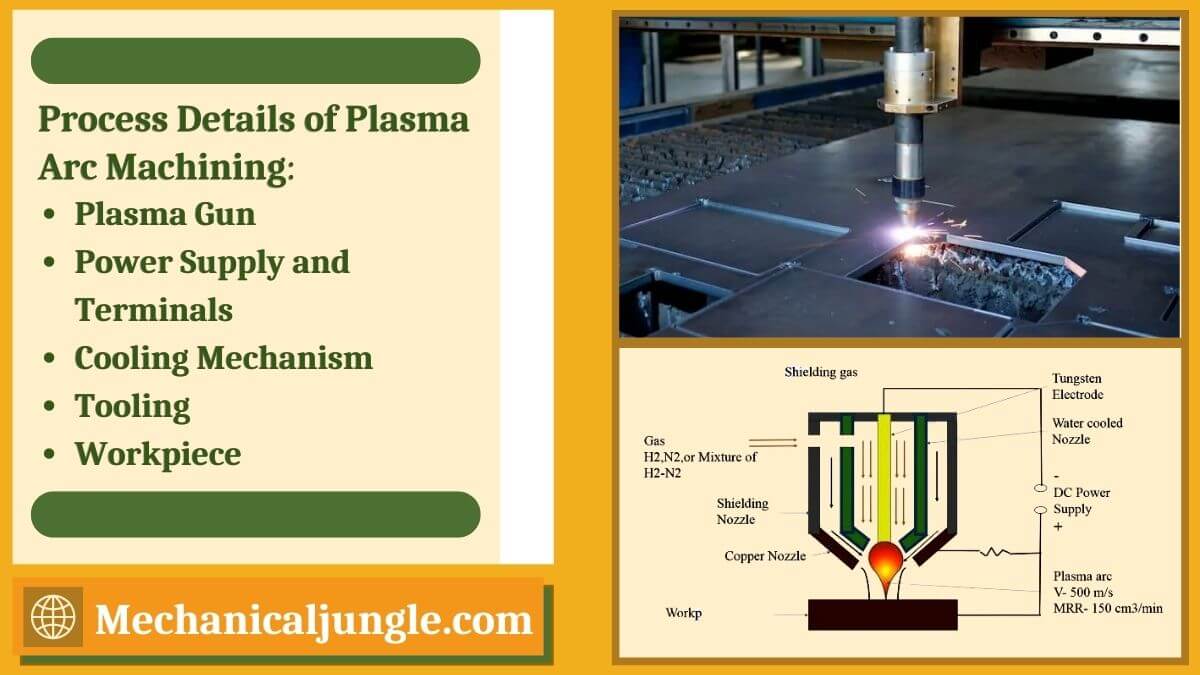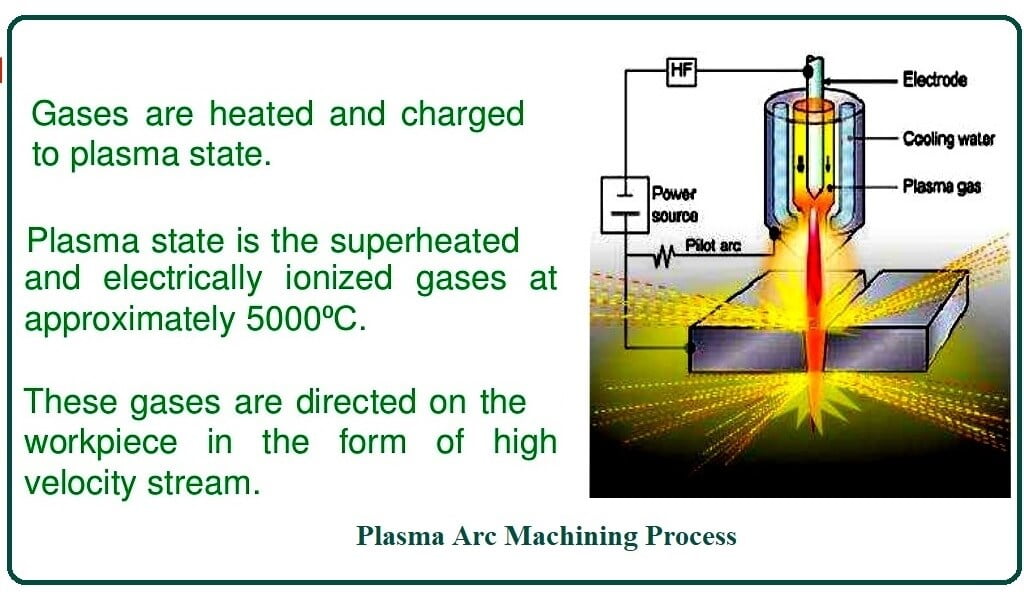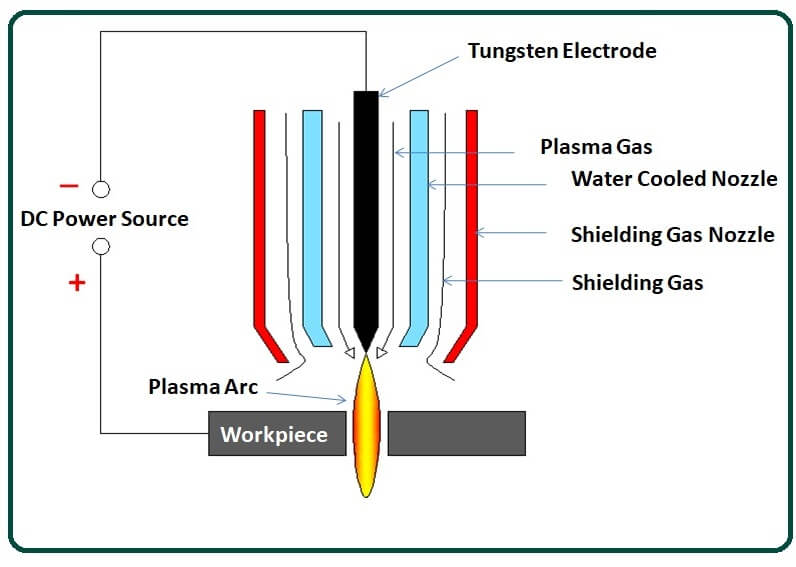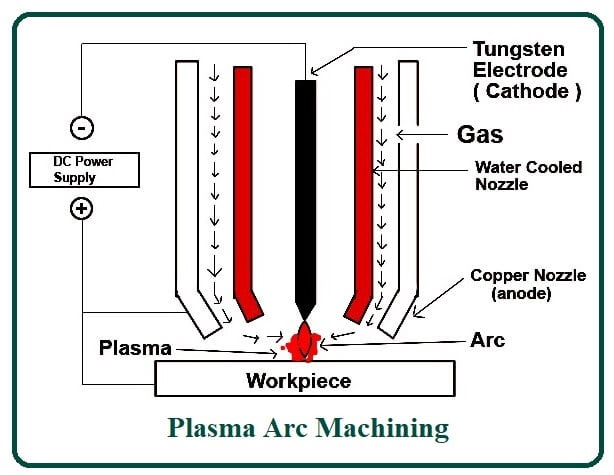Important Point
Plasma Arc Machining Process:
- The plank arch is used to remove material from the workpiece. In this process, a high-velocity jet of a high-temperature gauge is used to melt and remove material from the workpiece. This high velocity of hot gas is also known as place.
- When a gas or air is heated to a temperature of more than 5000 ° C, it will ionize into positive elements, negative elements, and neutral elements. When a gas or air is ionized, its temperature rises from 11000 ° C to 28000 ° C, and thus the gas gauge is called corrosion.
- The gas or air is heated by an arc, and the beverage pl by tap gas is used to remove materials from the workpieces. So the whole process is called a plot arc.
- In this process, a high velocity of high-temperature air is used to melt the material from the workpiece by melting.
- The gas used in the plume arc is chosen according to the metal that is used as the workpiece.
- Plot arc recordings are used to cut alloy steels, steel, online, nickel, copper, and cast iron.
Also, Read: Working of Radial Drilling Machine | What Is the Radial Drilling Machine | Parts of Radial Drilling Machine
Plasma Explained:
- When a solid is heated to a melting point, it turns into a liquid, and when a liquid is heated, it turns into a gas.
If the gas is heated to about 2000 ° C, the molecules will separate into individual atoms. - If the temperature is raised to around 3000 ° C, the electrons of the gas atoms will be displaced, and the atoms are ionized, and this ionized gas is called plasma.
What Is the plasma of Plasma Arc Machining?
- Solids, liquids, and gases are the three familiar states of matter. In general, when a solid is heated, it turns into a fluid, and the liquids eventually become gases.
- When a gas is heated to a sufficiently high temperature, the atoms (molecules) are divided into free electrons and ions. The kinetic properties of this gas of free electrons and ions are sufficiently different from the normal condensed gas. So, it can be considered.
- The fourth position of the case and is given a new name, PLASMA ‘. In other words, when the lower gas is heated to a sufficiently high temperature of the order of 11,000 ° C to 28,000 ° C, it becomes partially ionized and is known as a ‘plasma.’ It is a mixture of free electrons, positively charged ions, and neutral atoms.
- This plasma is used for the metal extraction process. The plasma arc machining process is used to cut alloy steels, stainless steel, cast iron, copper, nickel, titanium, and aluminum, etc.
Also, Read: What Is Single Plate Clutch | Construction of Single Plate Clutch | Working of Single Plate Clutch
Working Principle of Plasma Arc Machining:
- In the plasma arc machining process, the material is removed by directing a high-velocity jet of ionized gas at high temperatures (11000 ° C to 28,000 ° C) on the workpiece.
- This high-temperature plasma jet melts the contents of the workpiece.
Process Details of Plasma Arc Machining:
Five types of descriptions are given below.
- Plasma Gun.
- Power Supply and Terminals.
- Cooling Mechanism.
- Tooling.
- Workpiece.
1. Plasma Gun-
- Gases, like plasma, are used to make nitrogen, argon, hydrogen, or a mixture of these gases.
- The plasma gun consists of a tungstens electrode that is fitted into the chamber.
- The electrodes are given negative polarity, and the gun nozzle is given positive polarity.
- The supply of gases remains in the gun. A strong arc is established between two terminals, anodes, and cathode. There is a collision between the molecules of the gas and electrons of the established arc.
- As a result of this collision, the gas molecules ionize, and heat develops.
- This hot and ionized gas called plasmas is directed to the workpieces with high velocity.
- The installed arc is controlled by the supply rate of gases.
2. Power Supply and Terminals-
- A power supply (DC) is used to develop two terminals in a plasma gun.
- A tungsten electrode is inserted into the gun, and a cathode is made, and the gun nozzle is the anode.
- A massive potential difference is applied to the electrodes to develop a plasma state of gases.
3. Cooling Mechanism-
- As we know that hot gases continuously exit the nozzle; hence there is a possibility of heating it.
- Water jackets are used to surround the nozzle to avoid overheating.
4. Tooling-
- There is no directly visible device in pam. A concentrated spray of hoit, plasma state gases serves as cutting tools.
5. Workpiece-
- The workpiece of various materials can be processed by the pam process.
- These materials are aluminum, stainless steel, magnesium, and carbon and alloy steel.
- All materials that can be processed by LBM can also be processed by the pam process.
Construction of Plasma Arc Machining:
- The schematic arrangement of plasma arc machining is shown in fig.
- The plasma arc cutting torch picks up the tungsten electrode in a small chamber.
- These electrodes are connected to the negative terminal of a D.C. power supply. So it acts as a cathode.
- The positive terminal of a D.C. power supply is connected to the nozzle formed near the bottom of the chamber. So, the nozzle acts as an anode.
- A short passage is provided on one side of the torch to supply gas to the chamber.
- Since water is circulated around the torch, the water in the electrode and nozzle remains cool.
Working of Plasma Arc Machining:
- First, when a dc power is supplied to the circuit, a strong arc is produced between the cathode (electrodes) and the anode (nozzle).
- After that, gas is supplied to the chambers. This gas can be a mixture of hydrogen, nitrogen, argon, or gases chosen according to the metal being worked.
- The gas used in the process is heated using an arc generated between the cathode and the anode. This gas heats at very high temperatures from 11000 ° c to 28000 ° c.
- As the arc comes in contact with the gas, there is a collision between the electrons of the arc & the molecules of the gas, and the gas molecules will separate into different atoms.
- Due to the high temperatures generates by the arc, electrons from some atoms will be displaced, and the atoms are ionized (electrically charged), and the gas is converted into plasma. As the gas is ionized, a large amount of thermal energy is released.
- After the gas is ionized, this high temperature ionized gas is directed towards the workpiece with high velocity.
Electric arc has some other benefits, such as it increases the temperature of the ionized gas, makes the beam approximately parallel, and increases the velocity of the gas. - As the plasma jet approaches the workpiece, the plasma melts the workpiece, and the high-velocity gas blows the molten metal.
- In this way, plasm arc machining is used to remove material from the workpiece.
Also, Read: Forging And Its Types
Advantages of Plasma Arc Machining:
Followings are the advantages of pam that you must know :
- In plasma arc machinings, hard and brittle metals can be made easily.
- It can be applied to almost all types of metal.
- The best parts of this process are that we get a higher cutting rate.
- We obtain better dimensional accuracy in the case of machining small cavities.
- It is a simples process to carry out and is a very efficient process.
- It takes a large part in the automatic repairs of jet engine blades.
Disadvantages of Plasma Arc Machining:
Apart from the advantages of the plasmas arc machinings, let us discuss some of the disadvantages:
- Pam includes various equipment, but the cost of this equipment is very high.
- This entire machining process consumes high amounts of inert gases.
- Narrow surfaces are produced, which are unnecessary.
- The most damaging part of pam is that surface changes occur on the surface.
- The operator or person handling the entire process must take proper precautions.
- This process can affect the human eye; therefore, a proper googly or helmet must be worn by an operator.
Also, Read: What Is Pipe Joint? | Types of Pipe Joints
Applications of Plasma Arc Machining:
- It is mostly used for cryogenic, high-temperature corrosion-resistant alloys.
- It is also used in the case of titanium plates up to 8 mm thickness.
- PAM is used in nuclear submarine pipe systems and welding steel rocket motor cases.
- PAM is a staple for applications related to stainless tubes and tube mills.
Frequently Asked Questions (FAQ)
Plasma Jet Machining
In machine tool: Plasma arc machining (PAM) PAM is a method of cutting metal with a plasma-arc, or tungsten inert-gas-arc, torch. The torch produces a high-velocity jet of high-temperature ionized gas (plasma) that cuts by melting and displacing material from the workpiece.
Plasma Arc Machining Process
In the plasma arc machining process, the material is removed by directing a high-velocity jet of ionized gas at high temperatures (11000 ° C to 28,000 ° C) on the workpiece. This high-temperature plasma jet melts the contents of the workpiece.
Plasma Explained
Plasma is a form of matter in which many of the electrons wander around freely among the nuclei of the atoms. Plasma has been called the fourth state of matter, the other three being solid, liquid and gas. Normally, the electrons in a solid, liquid, or gaseous sample of matter stay with the same atomic nucleus.
Working Principle of Plasma Arc Machining
The basic principle is that the arc formed between the electrode and the workpiece is constricted by a fine bore, copper nozzle. This increases the temperature and velocity of the plasma emanating from the nozzle. The temperature of the plasma is in excess of 20 000°C, and the velocity can approach the speed of sound.
Applications of Plasma Arc Machining
It is mostly used for cryogenic, high-temperature corrosion-resistant alloys. It is also used in the case of titanium plates up to 8 mm thickness. PAM is used in nuclear submarine pipe systems and welding steel rocket motor cases.
Plasma Beam Machining
What is plasma arc machining? Plasma arc machining is a metal removal process in which the metal is removed by focusing a high-velocity jet of high temperature (11,000°C to 30,000°C) ionized gas on the workpiece.
Like this post? Share it with your friends!
Suggested Read –
- Water Jet Machining
- Difference Between Orthogonal and Oblique Cutting | Orthogonal Machining
- What Is Magneto Ignition System | How Does an Ignition System Work | How Does a Magneto Work | What Does a Magneto Do | Magneto Ignition System
- What Is a Synchromesh Gearbox? | Principle of Synchromesh Gearbox | Construction of Synchromesh Gearbox | Working of Synchromesh Gearbox
- Working of Constant Mesh Gearbox | What Is a Constant Mesh Gearbox? | Different Gear Ratios in Constant Mesh Gearbox | Construction of Constant Mesh Gearbox
- What Is Cupola Furnace? | Cupola Furnace Design । Cupola Construction | Purpose of Cupola | Working Principle of Cupola Furnace: | Advantages of Cupola Furnace | Disadvantages of Cupola Furnace | Applications of Cupola Furnace





Leave a Reply